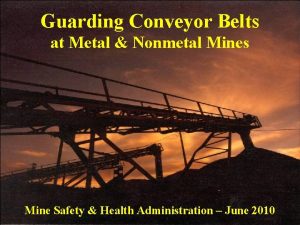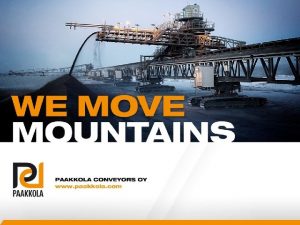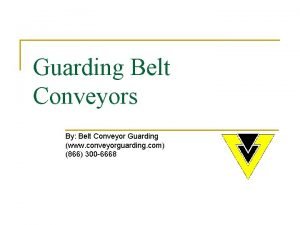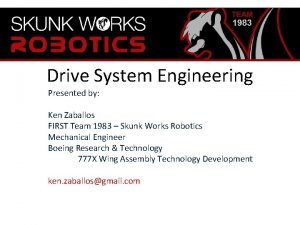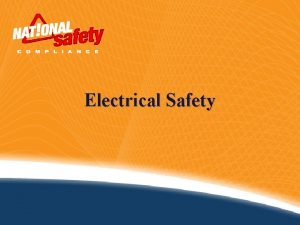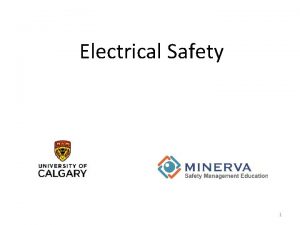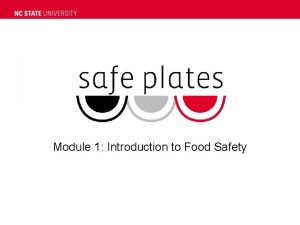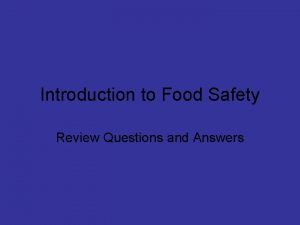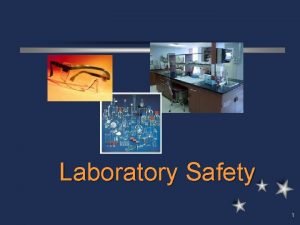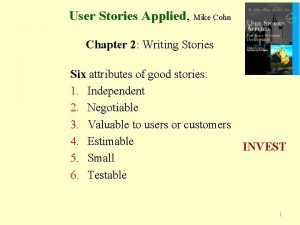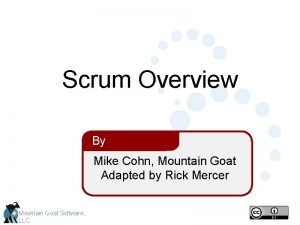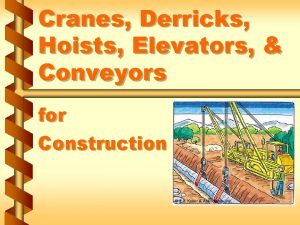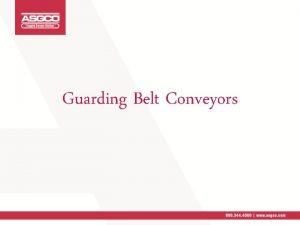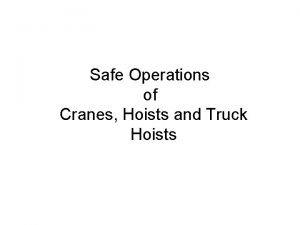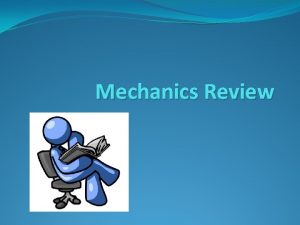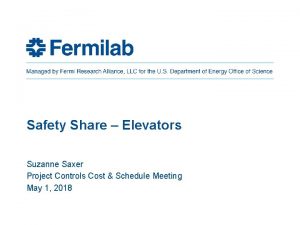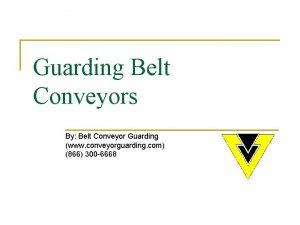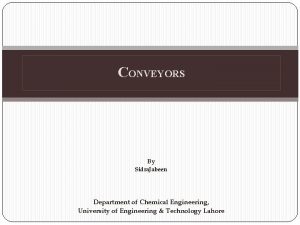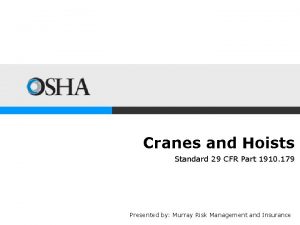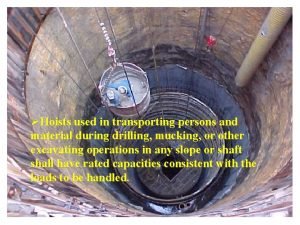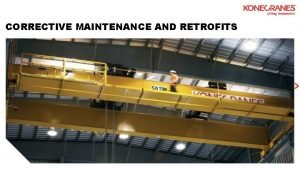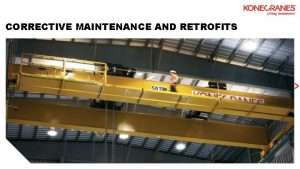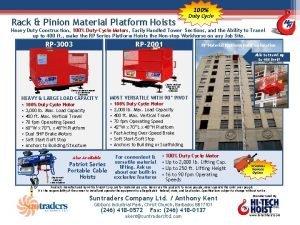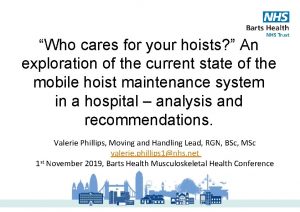Introduction to Hoists elevators and conveyors safety Mike

































- Slides: 33

Introduction to Hoists, elevators, and conveyors safety Mike Derr Insulators Local 23 Harrisburg PA


Definition Of A Hoist Noun. Lifting device for raising or lowering heavy or cumbersome objects.

Types of Hoists

Types of Hoists

DANGERS

What Should You NOT Do 1. 2. 3. 4. 5. 6. 7. 8. 9. 10. 11. DO NOT operate a damaged, malfunctioning or unusually performing hoist. DO NOT operate the hoist until you have thoroughly read and understood the manufacturer's Operating and Maintenance Instructions or Manuals. DO NOT operate a hoist which has been modified without the manufacturer's approval. DO NOT lift more than rated load for the hoist. DO NOT use hoist with twisted, kinked, damaged, or worn load chain or wire rope. DO NOT use the hoist to lift, support, or transport people. DO NOT lift loads over people. DO NOT operate a hoist unless all persons are and remain clear of the supported load. DO NOT operate unless load is centered under hoist. DO NOT attempt to lengthen the load wire rope or chain or repair damaged load wire rope or chain. DO NOT operate hoist when it is restricted from forming a straight line from hook to hook in the direction of loading.

What You Should Do While Operating A Hoist. Take up slack carefully - ensure load is balanced and load holding action is secure before continuing. 2. Shut down a hoist that malfunctions or performs unusually and report such malfunction. 3. Warn personnel of an approaching load. 4. Check brake function by tensioning the hoist prior to each lift operation. 5. Use hook latches. Latches are to retain slings, chains, etc. under slack conditions only. 6. Ensure the hook latches are closed and not supporting any parts of the load. 7. Ensure the load is free to move and will clear all obstructions. 8. Avoid swinging the load or hook. 9. Ensure hook travel is in the same direction as shown on the controls. 10. Inspect the hoist regularly, replace damaged or worn parts, and keep appropriate records of maintenance. 11. Use the hoist manufacturer's recommended parts when repairing the unit. 12. Lubricate load wire rope or chain per hoist manufacturer's recommendations. 13. Maintain a firm footing or be otherwise secured when operating the hoist. 1.

STORY TIME

General Area Safety Be Aware of Your Surroundings Communicate With Operator Know The Route of Intended Lift

A PAD EYE LIFTING LUG

Case History #8 Welder Struck by Plate A welder was working with the ship repair crew which was fitting a new 0. 5 -inch thick steel plate on the bottom hull of a tanker. The crew was working on an 8 -foot by 40 -foot plate which would patch the outboard port side between the center line and the bilge. Three chain-falls were used to lift the plate: two, 3 -ton capacity chain-falls and one, 1 ton chain-fall.

When the plate was raised, it was off by six inches and did not fit up to the hull. The welder began welding a pad eye to the edge of the plate so that a come-along could be attached and allow the plate to be pulled into position. While the welder was welding the pad eye, one of the interior pad eyes failed, resulting in a chain reaction that caused the plate to drop on the welder, crushing him.

The weight of the steel plate Using an online steel plate calculator I determined that the steel plate being installed by the ships repair crew weighed 6527. 2 LBS

Possible ways to prevent this type of accident: Do not work under suspended loads. Complete pre-work plan including hazard assessment, sequence of events and possible danger areas. Use blocks or shoring to support the load while work is being done. Ensure that the lift plan is approved and utilized.

Ensure that rigging equipment meets or exceeds requirements of lift and that a safety factor has been built in. Ensure that chain-falls are the same capacity when positioning loads. Ensure that the pad eyes are the appropriate size for their intended use and that the pad eyes are welded, not tack welded.

Hoist mechanisms

PPE Hard Hat Safety Glasses Gloves Safety Shoes High Visibility Clothing

Switching gears

Conveyor Safety https: //www. youtube. com/watch? v=Jm 1 VEO 9 C 4 VQ

What Do They Do For Us? They move materials efficiently and safely. but Just Like everything we work with, conveyors are safe correctly. Only when used

"Conveyor Safety" Find a way to cut down on the amount of materials you handle manually, and you've got a good thing going. You lessen the chances of hurting your back and hands, which are two of the more common types of on-the-job injuries. In addition, your capacity for work will increase and so will production. That's why conveyors are widely used.

NOT for human transportation! https: //www. youtu be. com/watch? v=C Wr. LZ 7 BVtp. Q https: //www. youtube. com/watch? v=Jg. O 5 Js. TVHxo

Conveyor Safety How Can They Hurt me?

WHAT COULD POSSIBLY GO WRONG https: //www. youtube. com/watch? v=ms. JD 7 Uh z 3 fc

Conveyor Safety Unless your job requires it, stay away from conveyors. Don't attempt to operate a conveyor unless you've been checked out on the procedures and are authorized to run it. Persons working on or about a conveyor should know the location and operation of stopping devices.

Fill In The _____. 1) Don't _____ over or under Conveyors. 2) Never ____on a conveyor. 3) Pinch points and moving parts must be ____. 4) If a conveyor runs overhead, precautions must be taken to prevent injuries from materials that may ____. 5) ____ clothing and jewelry should never be worn when working around conveyors.

Fill in the ______. Conveyors should be _______ and controls locked out when repairs are being made, and the equipment shouldn't be started again until it is certain that all is clear.

Regardless of whether you're working with conveyors or any other type of machinery, you're expected to observe basic safety rules. If You See Something SAY Something!!!

What Can Be Done To Protect The Worker

Grain Elevator Explosion History Records of grain elevator explosions have been documented for over 120 years. However, they have probably occurred from the time that structures for handling large amounts of grain were first developed

Five elevator explosions in the United States in December 1977, resulting in 59 deaths and 48 injuries.

The Recall Game
 Return roller guards for conveyors
Return roller guards for conveyors Paakkola conveyors
Paakkola conveyors Conveyor guarding
Conveyor guarding Cross bar elevator uses
Cross bar elevator uses Wedge principle of tooth extraction
Wedge principle of tooth extraction Single family home elevators
Single family home elevators Elevators definition
Elevators definition Vex pro sprocke
Vex pro sprocke Rei elevators
Rei elevators Catzoc ecdis definition
Catzoc ecdis definition Safety care certification
Safety care certification Process safety vs personal safety
Process safety vs personal safety Ind safety report
Ind safety report Basic safety construction site safety orientation
Basic safety construction site safety orientation Basic safety construction site safety orientation
Basic safety construction site safety orientation Mike and the battlefield team
Mike and the battlefield team Gnhq merchants
Gnhq merchants Mike murach & associates
Mike murach & associates Agile estimating and planning
Agile estimating and planning Electrical safety introduction
Electrical safety introduction Electrical safety introduction
Electrical safety introduction Module 1 introduction to food safety
Module 1 introduction to food safety Internet safety introduction
Internet safety introduction Introduction to food safety answers
Introduction to food safety answers Introduction to laboratory safety
Introduction to laboratory safety Mike williams erlang
Mike williams erlang Mike mazzalongo
Mike mazzalongo Story card example
Story card example Mike mazzalongo
Mike mazzalongo Mike mazzalongo sermons
Mike mazzalongo sermons Mike mazzalongo wikipedia
Mike mazzalongo wikipedia The cracked cup menu
The cracked cup menu Mike sobolewski
Mike sobolewski Mountain goat scrum
Mountain goat scrum
